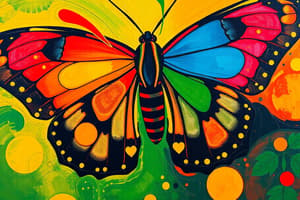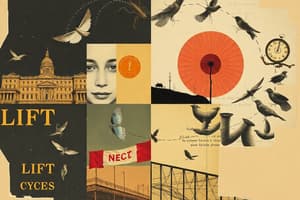Podcast
Questions and Answers
The life cycle of a butterfly consists of three stages: egg, pupa, and larva.
The life cycle of a butterfly consists of three stages: egg, pupa, and larva.
False (B)
A caterpillar grows larger throughout its pupal stage.
A caterpillar grows larger throughout its pupal stage.
False (B)
Inside the chrysalis, the caterpillar breaks down into imaginal discs.
Inside the chrysalis, the caterpillar breaks down into imaginal discs.
True (A)
The butterfly emerges from the egg ready to mate and lay eggs.
The butterfly emerges from the egg ready to mate and lay eggs.
Evaporation is the process where water vapor rises into the atmosphere due to the moon's heat.
Evaporation is the process where water vapor rises into the atmosphere due to the moon's heat.
The water cycle involves processes such as precipitation, runoff, and transpiration.
The water cycle involves processes such as precipitation, runoff, and transpiration.
Petals attract sunlight for photosynthesis.
Petals attract sunlight for photosynthesis.
Anthers are the female part of the flower responsible for receiving pollen grains.
Anthers are the female part of the flower responsible for receiving pollen grains.
Transpiration is the process where plants release oxygen into the atmosphere.
Transpiration is the process where plants release oxygen into the atmosphere.
The ovary of a flower contains the ovules which develop into seeds after fertilization.
The ovary of a flower contains the ovules which develop into seeds after fertilization.
Infiltration is when surface water flows into rivers, streams, or lakes.
Infiltration is when surface water flows into rivers, streams, or lakes.
Sepals enclose the flower bud and open to reveal the flower.
Sepals enclose the flower bud and open to reveal the flower.
Flashcards are hidden until you start studying
Study Notes
Butterfly Life Cycle
Butterflies go through a complete metamorphosis, which consists of four stages: egg, larva (caterpillar), pupa (chrysalis), and adult (butterfly). This process is also known as an insect's life cycle. In each stage, the butterfly transforms in response to environmental triggers.
- Egg: A female butterfly lays her eggs on leaves, twigs, or other plant surfaces where they wait to hatch into caterpillars.
- Larva (Caterpillar): Once hatched, a caterpillar begins eating the leaf it was laid on, growing larger throughout its larval stage. When it grows too big, it forms a chrysalis around itself.
- Pupa (Chrysalis): Inside the chrysalis, the caterpillar breaks down and becomes a jelly-like material called imaginal discs. These imaginal discs develop into the butterfly's adult structures.
- Adult (Butterfly): After several days or weeks, depending on the species, the butterfly emerges from the chrysalis, ready to mate and lay eggs to start the life cycle again.
Water Cycle
The water cycle, also known as the hydrologic cycle, describes the continuous movement of water on Earth. It involves a series of processes including evaporation, precipitation, infiltration, runoff, and transpiration.
- Evaporation: Water from the ocean and other bodies of water evaporates into water vapor, rising into the atmosphere due to the sun's heat.
- Precipitation: The water vapor cools and condenses into clouds, eventually falling as rain, snow, sleet, or hail.
- Infiltration: Some of the precipitation is absorbed by the ground and enters the soil, becoming groundwater.
- Runoff: Surface water that doesn't infiltrate becomes surface runoff, which can flow into rivers, streams, or lakes.
- Transpiration: Plants absorb water through their roots, evapotranspirationally releasing water vapor into the atmosphere, contributing to the water cycle.
Parts of a Flower
A flower is the reproductive structure of flowering plants. It has several parts, each with a specific function in the process of pollination.
- Petals: These colorful structures attract pollinators, such as insects, birds, or wind.
- Sepals: These protective structures enclose the flower bud and open to reveal the flower.
- Stigma: The stigma is the female part of the flower responsible for receiving pollen grains.
- Anthers: The anthers produce pollen, which is carried by pollinators to the stigma for fertilization.
- Pistil: The pistil is the female reproductive structure that contains the ovary, style, and stigma.
- Ovary: The ovary contains the ovules, which develop into seeds after fertilization.
- Style: The style is a slender, elongated structure that connects the stigma and ovary, guiding the pollen tube to the ovules.
- Filament: The filament supports the anther and helps to release the pollen.
These components work together to ensure the plant's reproduction and survival. Understanding these biological processes is crucial for appreciating the complex interplay between organisms and their environments.
Studying That Suits You
Use AI to generate personalized quizzes and flashcards to suit your learning preferences.




